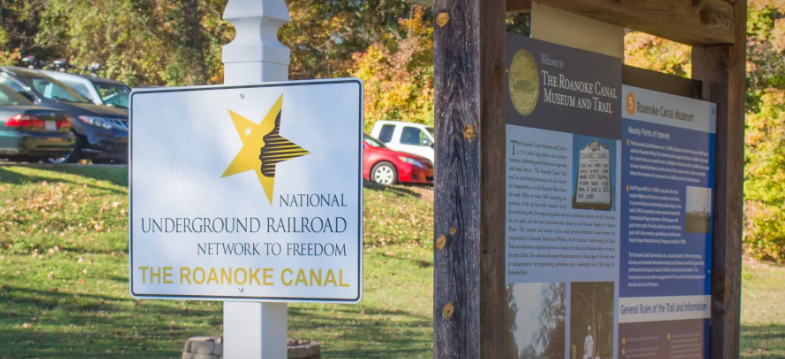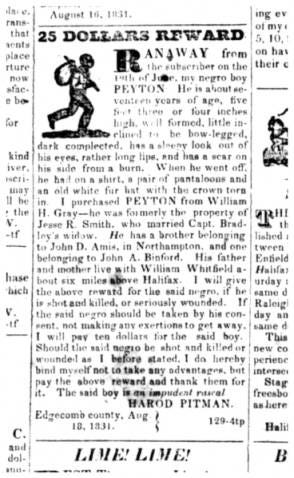Author: NC Department of Natural & Cultural Resources
Halifax, North Carolina, was an important part of the Underground Railroad in North Carolina. With the largest free Black population of any county in the state in the antebellum period, the community provided a network to help freedom seekers as well as a place to blend in.

They come often unannounced and with quiet pride and sometimes tears and once in a while with flowers. They walk the trails of the old town of Halifax, the Roanoke River, and the Roanoke Canal. They walk, and they think, and they try to conjure visions of what it must have been like for their great-great or great-great-great generation ancestors of the 1830s, ’40s, ’50s, and ‘60s.
Their ancestors came to Halifax County when it was part of what would become the profoundly historic Underground Railroad, the loosely defined houses and tunnels and waterways and networks of anonymous abolitionists in the South and North who helped freedom seekers to escape bondage and cruelty and violence on the Southern plantations and head North. Some were not so anonymous, John Brown and Harriet Tubman among them. But most were, some of them instilled with the Quaker faith, others just with righteous indignation about the mistreatment of their fellow human beings who happened to be of color.
Halifax County, close to the Virginia border, was a stop on that Railroad. The enslaved would use waterways to move to freedom, and Halifax had them. And now, those descendants stand next to those waterways, walk the trails the Freedom Seekers walked, and think about the people who left those unseen footsteps.
But not ghosts, no. Spirits. The Spirits of Freedom.
There’s an appropriate coincidence in that, of course. Halifax also was the site of the Halifax Resolves, a proclamation for freedom from Britain’s tyranny that got a jump, in April of 1776, on a little something called the Declaration of Independence.
But the Halifax connection to the Underground Railroad network was, while known, not nearly as celebrated as the Resolves, though the county and the town of Halifax have been making up for the lost time. And then some. There now are three sites connected to the Railroad recognized for their significance by the National Park Service.
That’s serious business to Lori Medlin, President and Chief Executive Officer of the Halifax County Convention and Visitors Bureau. A Halifax County native, she admits to going “big city” after graduation from Meredith College. “I moved to New York,” she says. “I got a job in tourism and traveled the world for 10 years. I did not want to come back to this little town.” But after working with some smaller communities in that big city job of hers, she was pulled home to help Halifax capitalize on tourism. She didn’t figure to stay long. That was 23 years ago. And in 2018, Halifax topped $100 million in the amount spent by visitors.
She didn’t hear much about the Underground Railroad growing up, Medlin said, and she’s never really known why. But after the Park Service gave historic designations to Halifax, a very gifted historian from N.C. State University named Dr. David Zonderman worked with her and her board to bring the history of Halifax to light and to life.

This newspaper advertisement for a runaway slave, published on Sept. 1, 1831, in the Roanoke Advocate, is one of many archived ads that give insight into the unique role Halifax County played in the Underground Railroad. Courtesy of the UNC-Greensboro Digital Library on American Slavery.
An important part of the record — Medlin is careful to say that Halifax doesn’t rely on casual stories or oral histories but on actual historic documents — are the ads placed in newspapers of the time by enslavers seeking to recapture runaways. The sites in Halifax prominently display reproductions of those ads as chapters in the region’s history. Hardly a proud chapter, but important to understand the atmosphere of the times and the hardships of those in slavery.
People who walk the dirt trail from the Halifax site to the riverbank will see signs with those ads for runaways on them and then come to the end with a spectacular overlook of the river. Visitors to all the designated sites can hear recordings from the memories of the slaves recalling their escapes and the risks they had to take.
For some who come, the trails are an immersion in history. For others, a very real touchstone to their family members of a time now approaching two centuries ago. Occasionally, as when one visitor left flowers at one of the sites, the Underground Railroad-connected sites are hallowed ground.
They are an acknowledgment of history — a very hard history — to courage, triumph over unspeakable adversity, to an almost unimaginable determination in the human spirit. People walked these trails from slavery to freedom.
What greater, or more difficult, journey could there be?
Learn more about the Halifax Underground Railroad: http://www.halifaxundergroundrr.com/
Hello NC is an initiative by the North Carolina Department of Natural and Cultural Resources to spotlight the people and places of rural North Carolina. We encourage, through these stories, people to stop and reconnect with places of historic and cultural significance.

